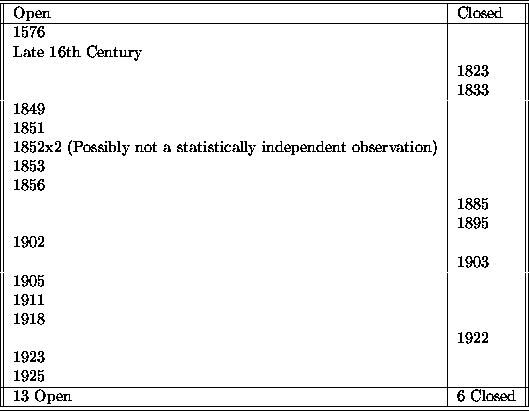Results of running the lake model for 1000 years with seed 765 using benchmark input data, and modeling virgin mouth conditions.
The silt levels range during period (years) [1950.83:2950.75] was [-5.50059:2.7109].
Time above sealevel during period [1950.83:2950.75] was 228.367 years. Time below upper bound 1e+300 during period [1950.83:2950.75] was 999.92 years.
The mean contribution of the Mfolozi to the lake was ![]() . (Compare this
with
. (Compare this
with ![]() for the mean natural inflow to the lake.) Due to aspects of how I modeled
this, the Mfolozi contribution may have even been lower. (Also this figure is sensitive to
the poorly calibrated mouth parameters.)
for the mean natural inflow to the lake.) Due to aspects of how I modeled
this, the Mfolozi contribution may have even been lower. (Also this figure is sensitive to
the poorly calibrated mouth parameters.)
The mouth was open for 77% of the time.
This result is in reasonable accordance with the historical record.
I found that this figure was surprisingly robust to changes in the mouth scour / deposition parameters. Why? I guess that the mouth only opens when a major flood is coming through, and as there is a strong correlation between floods in the Mfolozi and in the lake, any such flood will build up the lake level rapidly and hence bull-doze the mouth clear.
The Kriel report lists the following observations of the mouth state prior to the canalization of the Mfolozi in 1927.
Table 1 gives year of observation, and whether mouth was open or closed.

Table 1: Table listing historical observations of the state of the St.
Lucia mouth. Total of 19 independent samples.
The mouth was observed open 68% of the time in the precanalization days. The question we must then ask ourselves, is what does these observations really tell us about the actual probability of the mouth being open?
The 95% confidence interval on this is (46%,85%). The 50% confidence interval is (60%,74%). Thus we should happily accept any modeled value for the probability of the mouth being open as between 60% and 74%. We should perhaps query any model that gives less than 46% or more than 85%.
Running the model for 1000 years with the same seed, using present day inflows, modeling the mouth but keeping the Mfolozi mouth separate resulted in an interesting phenomena.
After an extended period (about 100 years), the mouth closed and never reopened (in a period of 900 years). This is not a bug in the program and is possibly not an invalid parameter or mouth model. (Although the situation would certainly go away with different mouth parameters.)
Consider....
Thus in conclusion, without a better calibration of the mouth parameters, the following possibility must be considered :- Under present day flow conditions, with separate mouths and no dredging, the lake may permanently become a land locked.
Note :- Under flood conditions the "land-locked" lake levels rise considerably higher than the low-lying flood plain between the estuary and the Mfolozi. Thus what would in fact happen would be...
During the 112 year period in which the mouth still functioned, the mouth was open for 44% of the time. This figure is probably sensitive to a better mouth model / calibration of the mouth parameters.
I could do Monte Carlo trials to determine what the probability of permanent closure is, but this figure would be very sensitive to the mouth model / parameters, and would take a hell of a lot of computer time. Thus I propose that to leave it as "the possibility must be considered" for now.
An additional non-important side note is...